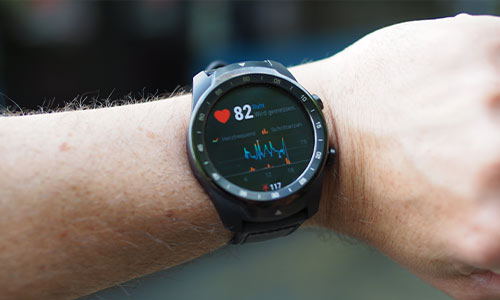The Importance of Resting Heart Rate for Runners: What You Need to Know
Running is a simple yet exhilarating sport that allows you to connect with nature and improve your overall well-being. While using advanced trackers and technology during your runs is a personal choice, there is one crucial measurement that every runner, from beginners to marathoners, should pay attention to—the resting heart rate (RHR). Monitoring your RHR provides valuable insights into your cardiovascular health and fitness levels. In this blog, we will explore the significance of resting heart rate for runners and its impact on your running performance and overall well-being.

Understanding Resting Heart Rate:
Resting heart rate is the number of times your heart beats per minute while you are at rest. It reflects how efficiently your heart circulates blood through your body. Generally, a lower resting heart rate indicates that your heart is functioning with ease, while a higher rate may suggest that your cardiovascular health and fitness levels need attention.
- Factors Affecting Resting Heart Rate:
Various factors can influence your resting heart rate, including genetics, age, weight, medications, mood, sleep patterns, caffeine intake, diet, tobacco use, and hydration status. Additionally, your exercise habits and training intensity play a significant role. Regular runners, especially those engaged in intense workouts, may experience lower resting heart rates, even down to the 40s.
- Measuring Resting Heart Rate:
Measuring your resting heart rate is a simple process that requires finding your pulse and using a timer or clock. For accuracy, measure your heart rate immediately upon waking, before sitting up in bed. Alternatively, you can measure it after resting for five minutes in a sitting or lying position. Locate your pulse in your wrist (radial artery) or neck (carotid artery), count the beats for 30 seconds, and then multiply the number by two. Repeat the process after one minute and average the two values.
- The Significance of Resting Heart Rate for Runners:
Knowing your resting heart rate is essential for tracking your cardiovascular fitness journey. As you engage in a regular aerobic exercise like running, you may observe a decline in your resting heart rate over time, indicating improved cardiovascular efficiency. Typically, runners witness changes in their resting heart rate within three to four months of consistent training. Monitoring this change allows you to gauge the effectiveness of your workouts and overall fitness level.
- Potential Impact of Overtraining on Resting Heart Rate:

Although regular aerobic exercise benefits cardiovascular health, overtraining can lead to temporary fluctuations in resting heart rate. Overtraining-induced stress and inflammation can initially cause an increase in your resting heart rate. If overtraining progresses to a state known as overtraining syndrome, runners may experience a slowed or increased resting heart rate, depending on their primary training focus. Recognizing these signs can help you adjust your training regimen to avoid potential burnout and optimise performance.
- Seeking Medical Attention:
If you experience unusual spikes in your resting heart rate, accompanied by symptoms like dizziness, chest pain, palpitations, shortness of breath, or nausea, consult a physician promptly. It's essential to prioritise your health and seek professional guidance if any concerning symptoms arise during your running journey.
Conclusion:
Resting heart rate is a vital metric for runners, providing valuable insights into cardiovascular health and overall fitness levels. By consistently monitoring your resting heart rate, you can track your progress, optimise training, and ensure a safe and enjoyable running experience. Remember, while technology and trackers can be beneficial, the simple act of measuring your resting heart rate with basic tools can significantly contribute to your overall well-being as a runner
-
 Skechers Mens Telphin Sanphet Lace Up Slip Resistant Shoes£68.95RRP £79.00 Save Up To £10.05
Skechers Mens Telphin Sanphet Lace Up Slip Resistant Shoes£68.95RRP £79.00 Save Up To £10.05
Categories
- Sport (28)
- Product Reviews (3)
- Team Outdoor Look (7)
- Mike Wild (2)
- Mike Payton (2)
- Suse Hammond-Pears (3)
- Snowboarding (12)
- Latest Offers (105)
- Shop Talk (1)
- Competitions (7)
- Walking (413)
- Lifestyle Fashion (8)
- Travel (86)
- Kit Guides (176)
- Workwear Clothing (6)
- Safety Workwear (4)
- Health/Fitness (289)
- Skiing (91)
- Great Outdoors (1316)
- Cycling (92)
- January 2025
- December 2024
- November 2024
- October 2024
- September 2024
- August 2024
- July 2024
- June 2024
- May 2024
- April 2024
- March 2024
- February 2024
- January 2024
- December 2023
- November 2023
- October 2023
- September 2023
- August 2023
- July 2023
- June 2023
- May 2023
- April 2023
- March 2023
- February 2023
- January 2023
- December 2022
- November 2022
- October 2022
- September 2022
- August 2022
- July 2022
- June 2022
- May 2022
- April 2022
- March 2022
- February 2022
- January 2022
- December 2021
- November 2021
- October 2021
- September 2021
- August 2021
- July 2021
- June 2021
- May 2021
- April 2021
- March 2021
- February 2021
- January 2021
- December 2020
- November 2020
- October 2020
- September 2020
- August 2020
- July 2020
- June 2020
- May 2020
- April 2020
- March 2020
- February 2020
- January 2020
- December 2019
- November 2019
- October 2019
- September 2019
- August 2019
- July 2019
- June 2019
- May 2019
- April 2019
- March 2019
- February 2019
- January 2019
- December 2018
- November 2018
- October 2018
- September 2018
- August 2018
- July 2018
- June 2018
- May 2018
- April 2018
- March 2018
- February 2018
- January 2018
- December 2017
- November 2017
- October 2017
- September 2017
- August 2017
- July 2017
- June 2017
- May 2017
- April 2017
- March 2017
- February 2017
- January 2017
- December 2016
- November 2016
- October 2016
- September 2016
- August 2016
- July 2016
- June 2016
- May 2016
- April 2016
- March 2016
- February 2016
- January 2016
- December 2015
- November 2015
- October 2015
- September 2015
- August 2015
- July 2015
- June 2015
- May 2015
- April 2015
- March 2015
- February 2015
- January 2015
- December 2014
- November 2014
- October 2014
- September 2014
- August 2014
- July 2014
- June 2014
- May 2014
- April 2014
- March 2014
- February 2014
- January 2014
- December 2013
- November 2013
- October 2013
- September 2013
- August 2013
- July 2013
- June 2013
- May 2013
- April 2013
- March 2013
- February 2013
- January 2013
- December 2012
- November 2012
- October 2012
- September 2012
- August 2012
- July 2012
- June 2012
- May 2012
- April 2012
- March 2012
- February 2012
- January 2012
- December 2011
- November 2011
- October 2011
- September 2011
- August 2011
- May 2010
- April 2010
- March 2010
- February 2010
- January 2010
- November 2009
- October 2009
- September 2009


Submit a Comment